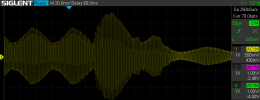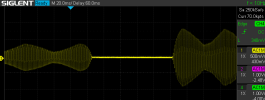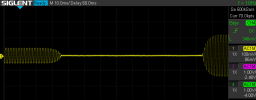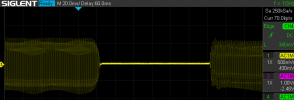BobXX
Inspired
[ Part 1 here - Measurements and Info ]
[ Part 2 here - Measurements and Info ] current
[ Part 3 here - Measurements and Info ]
[ Part 4 here - Tips & Tricks ]
[ Part 5 here - Tips & Tricks ]
[ Part 6 here - Tips & Tricks - GAP "FILLER": GAPLESS Proof of Concept ]
Finally from the measurements shown, we can divide the blocks (on the audio gap point of view) into three groups:
 even going a littlo beyond the "safe" limit of 80% CPU, but using ONLY "gapless" blocks:
even going a littlo beyond the "safe" limit of 80% CPU, but using ONLY "gapless" blocks:

I set Scene 1 with all blocks set to Channel A,
and Scene 2 with all blocks set to Channel B, even selecting a different type of block than channel A (17 block type changes).
so toggling scenes 1 and 2 it switches channel and types of all blocks ,
,
NO AUDIO GAPS !
Here's the audio out:

I didn't believed my ears and eyes... it's a really extreme preset.
Suspecting that echoes could cover a gap, I set all delay&reverb effects and modulations to 100% dry: no gaps again.

Not convinced yet.
As a counterproof, I tried to substitute first block of the chain with a COMPRESSOR (gap inducing block), I chose to put it at the beginning on purpose to capture every following time modulations.
The audio gap appears... (~100ms):

(This image is "zoomed out" so every division is 20ms)
This seems to confirm that all those "gapless" blocks (see the list in Part 1) in all my tests, for the time being, never induce audio gaps.
QUESTION: "Using gap inducting blocks, do they cause gaps in all sound chains of the preset?" ANSWER: No.
AFAIK, it appears only in the sound chains that have a "gap inducting block" (see list here).
More precisely it appears in the part of the chain in series that has this type of blocks. Any parallel processing seems not to be affected. We will se that this allow some interesting trick.
For instance in this case we have the first chain 100% made of gapless blocks, the second chain has only a CHORUS, not gapless:

This is the output of OUT3, first huge chain, no gaps:

This is the output of OUT2, second chain, only 1 block, a gap of 90ms appears.
We will see in Part 3 why is not the 12ms reported as its minimum in table of Part 1:

If I entirely remove the big chain IN1-OUT3, leaving in the preset only 1 CHORUS, the gap narrows to its minimum 12ms.
NOTE: It appears to me pretty strange that given the extreme crazy complexity of that gapeless chain, where AXE FX3 is able to manage everything - I mean, even 17 block's type changes in a shot - without any sound gap.
On the contrary if all AF3 huge power have to deal with just 1 CHORUS or 1 COMPRESSOR and nothing else in the preset, we get a gap.
It looks like a bag or something forgotten. Maybe developers will fit this in the future.
Let's see now what happens when more "gap inducing" blocks have channel switched:
[ Part 3 here - Measurements and Info ]
[ Part 2 here - Measurements and Info ] current
[ Part 3 here - Measurements and Info ]
[ Part 4 here - Tips & Tricks ]
[ Part 5 here - Tips & Tricks ]
[ Part 6 here - Tips & Tricks - GAP "FILLER": GAPLESS Proof of Concept ]
Finally from the measurements shown, we can divide the blocks (on the audio gap point of view) into three groups:
- "Gapless" blocks, regardless the number of blocks, channel and types changes
- Small gap blocks with a 12ms typical minimum gap
- AMPs... that induce a typical gap of 40ms

I set Scene 1 with all blocks set to Channel A,
and Scene 2 with all blocks set to Channel B, even selecting a different type of block than channel A (17 block type changes).
so toggling scenes 1 and 2 it switches channel and types of all blocks
NO AUDIO GAPS !
Here's the audio out:

I didn't believed my ears and eyes... it's a really extreme preset.
Suspecting that echoes could cover a gap, I set all delay&reverb effects and modulations to 100% dry: no gaps again.

Not convinced yet.
As a counterproof, I tried to substitute first block of the chain with a COMPRESSOR (gap inducing block), I chose to put it at the beginning on purpose to capture every following time modulations.
The audio gap appears... (~100ms):

(This image is "zoomed out" so every division is 20ms)
This seems to confirm that all those "gapless" blocks (see the list in Part 1) in all my tests, for the time being, never induce audio gaps.
QUESTION: "Using gap inducting blocks, do they cause gaps in all sound chains of the preset?" ANSWER: No.
AFAIK, it appears only in the sound chains that have a "gap inducting block" (see list here).
More precisely it appears in the part of the chain in series that has this type of blocks. Any parallel processing seems not to be affected. We will se that this allow some interesting trick.
For instance in this case we have the first chain 100% made of gapless blocks, the second chain has only a CHORUS, not gapless:

This is the output of OUT3, first huge chain, no gaps:

This is the output of OUT2, second chain, only 1 block, a gap of 90ms appears.
We will see in Part 3 why is not the 12ms reported as its minimum in table of Part 1:

If I entirely remove the big chain IN1-OUT3, leaving in the preset only 1 CHORUS, the gap narrows to its minimum 12ms.
NOTE: It appears to me pretty strange that given the extreme crazy complexity of that gapeless chain, where AXE FX3 is able to manage everything - I mean, even 17 block's type changes in a shot - without any sound gap.
On the contrary if all AF3 huge power have to deal with just 1 CHORUS or 1 COMPRESSOR and nothing else in the preset, we get a gap.
It looks like a bag or something forgotten. Maybe developers will fit this in the future.
Let's see now what happens when more "gap inducing" blocks have channel switched:
[ Part 3 here - Measurements and Info ]
Attachments
Last edited:


